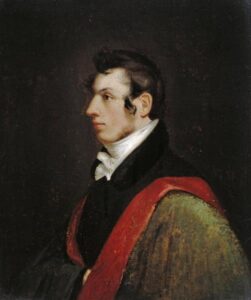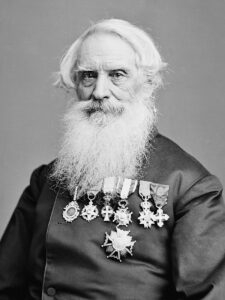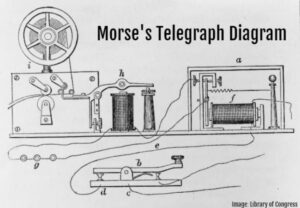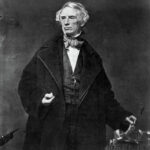
 When we hear the name Samuel Morse, most of us might think of the Morse Code, and we would be right in thinking of that connection, but Morse would also be the inventor of Morse Code’s companion invention…the telegraph, which was debuted on January 6, 1838, at the Speedwell Iron Works in Morristown, New Jersey. His telegraph, a device that utilized electric impulses to transmit encoded messages over a wire, which ultimately revolutionized long-distance communication, achieving the peak of its popularity in the 1920s and 1930s. After that era, the telegraph, like most technology was outshined by the next big thing.
When we hear the name Samuel Morse, most of us might think of the Morse Code, and we would be right in thinking of that connection, but Morse would also be the inventor of Morse Code’s companion invention…the telegraph, which was debuted on January 6, 1838, at the Speedwell Iron Works in Morristown, New Jersey. His telegraph, a device that utilized electric impulses to transmit encoded messages over a wire, which ultimately revolutionized long-distance communication, achieving the peak of its popularity in the 1920s and 1930s. After that era, the telegraph, like most technology was outshined by the next big thing.
Samuel Finley Breese Morse was born on April 27, 1791, in Charlestown, Massachusetts. He was the first child of the Pastor Jedidiah Morse, who was also a geographer, and his wife Elizabeth Ann Finley Breese. He attended Yale University, where he developed an interest in both art and electricity, which was still in its infancy at the time. After college, Morse pursued a career as a painter. In 1832, while sailing home from Europe, he learned about the newly discovered electromagnet and conceived the idea for an electric telegraph. What he didn’t know was that other inventors were already working on that very concept. Samuel Morse married Lucretia Pickering Walker on September 29, 1818, in Concord, New Hampshire. She died on February 7, 1825, of a heart attack shortly after the birth of their third child. Their children were Susan born 1819, Charles born 1823, and James born 1825. He married his second wife, Sarah Elizabeth Griswold on August 10, 1848, in Utica, New York and had four children, Samuel born 1849, Cornelia born 1851, William born 1853, and Edward born 1857.
Morse dedicated the next several years to developing a prototype. He enlisted the help of Leonard Gale and Alfred Vail to aid him in the process. In 1838, he showcased his invention using Morse code, where dots and dashes represented letters and numbers. By 1843, Morse successfully persuaded a skeptical Congress to finance the construction of the first telegraph line in the United States, stretching from Washington DC to Baltimore. In May 1844, Morse sent the first official telegram over this line, with the message: “What hath God wrought!” That must have been an epic event in his life.
In the following years, private companies, utilizing Morse’s patent, established telegraph lines throughout the Northeast. In 1851, the New York and Valley Printing Telegraph Company was founded, later renaming itself Western Union. By 1861, Western Union had completed the first transcontinental line across the United States. Western Union is still in use today, mainly processing money transfers, but it’s likely they use more modern methods of processing their telegrams. Five years after the first transcontinental like was completed, the first successful permanent line across the Atlantic Ocean was constructed, and by the end of the century, telegraph systems had been established in Africa, Asia, and Australia.
Due to telegraph companies typically charging by the word, telegrams became known for their concise prose, regardless of whether they conveyed happy or sad news. The word “stop,” which was free, was used in place of a period, for which there was a charge. In 1933, Western Union introduced singing telegrams. During World War II, Americans grew to dread the sight of Western Union couriers, as the military used telegrams to inform families of soldiers’ deaths. It was efficient, but the sight of the couriers foretold the message all too often.

 Throughout the 20th century, telegraph messages were largely replaced by affordable long-distance phone, faxes, and email. Western Union sent its last actual telegram in January 2006. That fact shows the versatility of the telegraph, and why it was such a great source of wealth for Samuel Morse. For this and other reasons Samuel Morse never lost his fame and popularity. He died of pneumonia, in New York City on April 2, 1872, at the age of 80. At the time of his passing, he was a wealthy man. His fame has long surpassed his years.
Throughout the 20th century, telegraph messages were largely replaced by affordable long-distance phone, faxes, and email. Western Union sent its last actual telegram in January 2006. That fact shows the versatility of the telegraph, and why it was such a great source of wealth for Samuel Morse. For this and other reasons Samuel Morse never lost his fame and popularity. He died of pneumonia, in New York City on April 2, 1872, at the age of 80. At the time of his passing, he was a wealthy man. His fame has long surpassed his years.


Leave a Reply